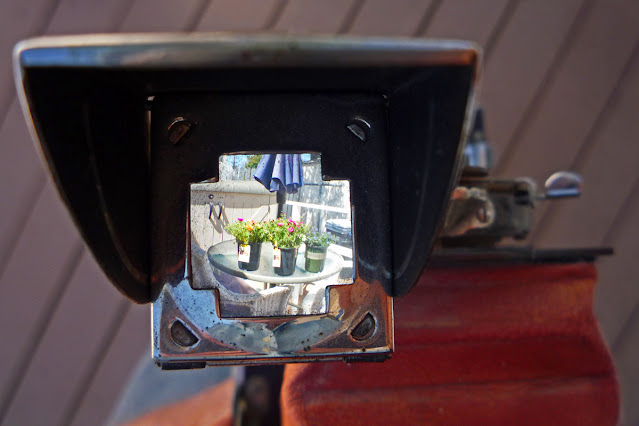A newcomer to the Friday morning car klatch in Old Town stirred some interest.
I think this car started out as a '36 Plymouth, but it has been extensively modified.
These shots are from my No.1A Folding Kodak Special with a four-elements-in-two-groups Rapid Rectilinear lens. The outer covering of my camera is quite deteriorated, but the shutter works fine and there are no pinholes in the red bellows.Turn-of-the-century cameras are interesting because camera control features tended to vary a lot from one manufacturer to the next. The shutter on this camera, for instance, includes a frame counter that was actuated by the shutter release, which was best operated with a pneumatic bulb. The aperture settings are designated by the U.S. standard of the time rather than the current f-stop ratio values.
The focusing scale has settings only for 6, 10, 25 and 100 feet. Turning the thumb wheel brings a pin into position which serves as a stop when the lens/shutter mount is pulled forward. Because of the short length of the scale, distances between the indicated stops cannot be easily determined and set, so bright shooting light and small apertures are helpful to achieving proper depth of field.
One very nice feature of the 1A Special was a reflex finder that was very large and bright compared to those of later Kodak folders. Mine is especially easy to use thanks to the replacement of the original deteriorated mirror by a mirror sliced from an old Polaroid camera.
I have only shot 120 roll film in my 116 cameras and that requires a bit of ingenuity in loading and advancing the film. The big 116 spools are held in place by spring-loaded pins. To use the camera with 120 film spools I made a film holder from an Adox plastic film can and foam spacers. When operating the camera, the ruby window is covered and the film is advanced by two-and-one-half turns of the advance key to achieve adequate spacing, yielding five or six frames per roll. It is also possible these days to acquire 3D-printed spacers to properly hold the 120 film spools in position.









